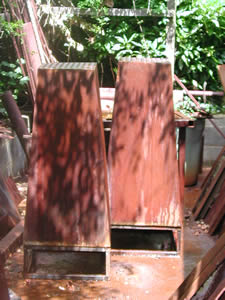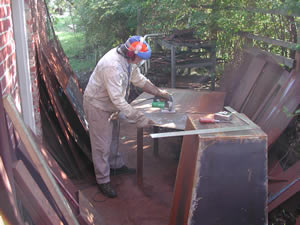WTC
WTC is the eighth of a series of sculptures referred
to as "Chimneys".
The series originated about a year before the attack of September
11, but the image naturally fitted into the series.

The sculpture is more about architecture than it is about terrorism.
The towers actually appear to be falling, but this was not the
original concept. Ambiguity is one of the beautiful things about
sculpture. The way the towers slope is actually a play on reverse
perspective. If you look up an object, it appears smaller at
the top. Because you are looking down on the sculptor, it would
appear narrower at the base. What I am aiming at is an inversion,
where what is perceived is the total opposite of what is expected.
The choice of diamond plate steel for the walls was partly accidental.
I had intended to use diamond plate on the top, and smooth plate
for the walls of the tower. However, because I ran out of steel
in the studio ( a rare occurrence ), I decided to use diamond
plate for the outer walls ( running out of it too ). This means
that any water running down the outside walls will actually
resemble tears.
The diamond plate on the top has an uneasy ambiguity. You associate
diamond plate with something on which you walk. After September
11, the observation deck of the WTC, was at ground level - this
association was intentional.
The saddest ambiguity is that the color of steel ( iron red
) is also the color of blood ( which gets its color from iron
).
This piece has taken a lot of time and energy to develop. There
may be one or two more sculptures in the series, but my feeling
at the moment is that I'd really like to just do some play sculpture,
which I haven't done in ages. A recent article in Apollo magazine
stated that cubist sculpture was unsuccessful because it could
not address the concerns of cubist painting, esp transparency
and ambiguity of vision. I think this is wrong, and the concept
is a good starting point for a series of sculptures. ( It is
not unusual for a article like this to trigger a series of works.
A statement by Edward Tufte that art could not address a changing
image has been a major trigger for the Chimneys series. What
Tufte says art cannot address is common in art and is called
Narrative or Serialization. )






